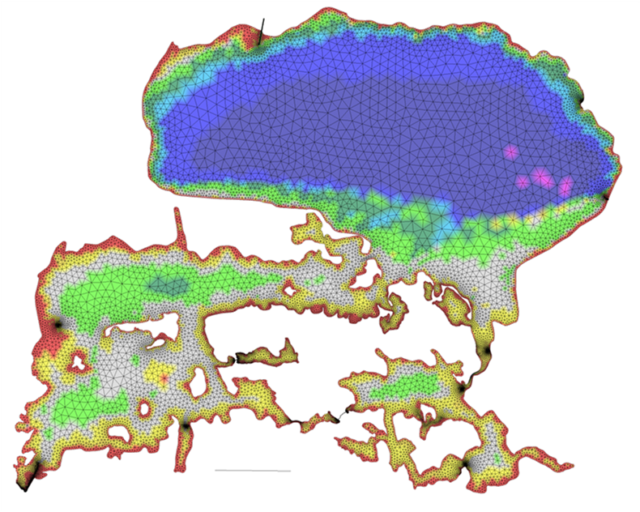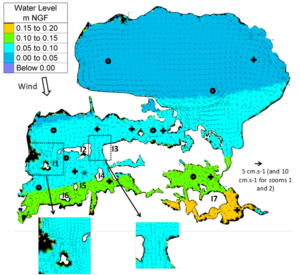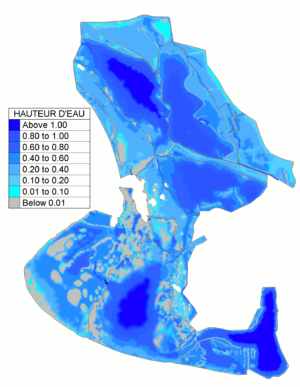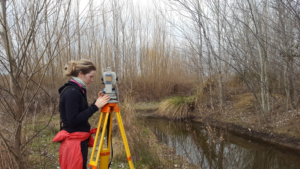Hydrological system modelling
Objective
The aim of this project is to model the functioning of Camargue lagoon hydrological systems in terms of water, salt, and temperature dynamics. Their catchment areas, as well as the coastal strips linked to these lagoons, are also analysed.
The principal model used is made with TELEMAC-2D and -3D software. This model can account for typical hydrological measurements (water level, flow rate, salinity, temperature), at each node in an unstructured mesh, as illustrated in figure 1.

The hydrological, thermal, and saline functioning of the lagoon systems studied can be characterised by the models developed by our team, as illustrated in figures 2 and 3.
 |
 |
Figure 2. Average currents generated by a northwest wind episode (direction wind is coming from) on the Vaccarès hydrological system (Boutron et al., 2015) |
Figure 3. Water level simulation (m) for the lagoons and marshes of the former Camargue saltworks site |
These models can be used to test the influence of different water management operations (using hydraulic infrastructure, hydraulic works, etc) on the hydrological, thermal, and saline functioning of the study sites. They are thus used to define the conservation, restoration, and management actions to be implemented on the sites.
The medium-term aim is to be able to use them to provide indications on the consequences of climate change on this functioning.
At the same time as it develops these models, our team is setting up and making use of a network of hydrological indicators for the Camargue, which provides it with the experimental data needed to validate the models developed.
Our team also works very closely with the Tour du Valat Species Department – the hydrological, thermal, and salinity models developed are combined with the epidemiological and species population dynamics models monitored by this Department.
Team
- Project leader: Olivier Boutron [1]
- Staff involved: Émilie Laurent [2], Samuel Hilaire [3], Antoine Arnaud [4]
- Date of project: Since 2015
Partners
Technical partners
- SNPN [5]
- PNR Camargue [6]
- ARTELIA [7]
- Université Joseph Fourrier (Grenoble) [8]
Financial partners
- Rhone-Mediterranean and Corsica Water Agency [9]
- Provence-Alpes-Côte d’Azur [10]Region [10]
- Fondation TOTAL [11]
Significant publications since 2015 (not including hydrological expertise and engineering studies)
- Boutron O., Bertrand O., Fiandrino A., Höhener P., Sandoz A., Chérain Y., Coulet E., Chauvelon P. 2015. An Unstructured Numerical Model to Study Wind-Driven Circulation Patterns in a Managed Coastal Mediterranean Wetland: The Vaccarès Lagoon System. Water 7:5986–6016. Doi : 10.3390/w7115986.
- Vallet-Coulomb C., Delattre H., Sonzogni C., Boutron O., 2015. Combining isotopic measurements of atmospheric vapor and lagon water for analysing isotope fractionnation during evaporation. IAEA International Symposium on Isotope Hydrology: Revisiting Foundations and Exploring Frontiers, At Vienna, Austria
- Lambret P., Boutron O., Massez G. Étude de l’écologie de Lestes macrostigma et restauration de son habitat. Le courrier de la nature n°296.
- Diepens N.J., Chérain Y., Coulet E., Probst A., Buffan-Dubau E., Kallerhoff J., Merlina G., Silvestre J., Boutron O., Grillas P. and Elger A. Multiple stressors influencing seagrass dynamics in a shallow Mediterranean lagoon. SETAC 2016, Toulouse.
- Sandoz A., Leblond A., Boutron O., 2016. Modelling hydrological changes in surface in relation with anthropogenic drivers and consequences on human health and local economic. EGU General Assembly, Vienna.
- Vittecoq M., Gauduin H., Oudart T., Bertrand O., Roche B., Guillemain M., Boutron O. 2017. Modeling the spread of avian influenza viruses in aquatic reservoirs: A novel hydrodynamic approach applied to the Rhône delta (southern France). Science of The Total Environment 595:787-800. DOI : http://dx.doi.org/10.1016/j.scitotenv.2017.03.165.
